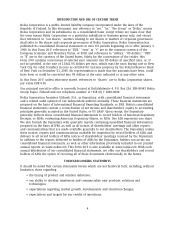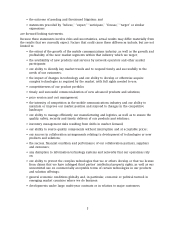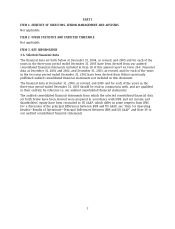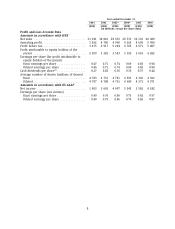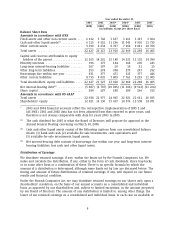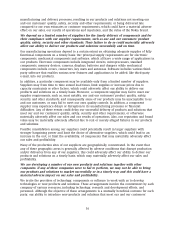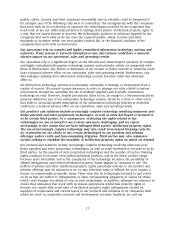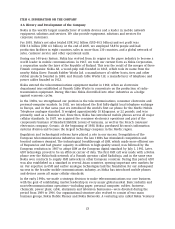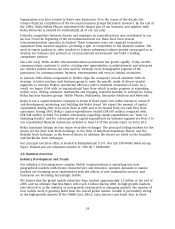Nokia 2005 Annual Report Download - page 16
Download and view the complete annual report
Please find page 16 of the 2005 Nokia annual report below. You can navigate through the pages in the report by either clicking on the pages listed below, or by using the keyword search tool below to find specific information within the annual report.In order to succeed in our markets, we believe that we must develop or otherwise acquire
complex, evolving technologies to use in our business. However, the development and use of new
technologies, applications and technology platforms for our mobile devices involves time,
substantial costs and risks both within and outside of our control. This is true whether we
develop these technologies internally, acquire or invest in other companies with these technologies
or collaborate with third parties on the development of these technologies.
The technologies, functionalities and features on which we choose to focus may not achieve as
broad or timely customer acceptance as we expect. This may result from numerous factors
including the availability of more attractive alternatives or a lack of sufficient compatibility with
other existing technologies, products and solutions. Additionally, even if we do select the
technologies, functionalities and features that customers ultimately want, we or the companies
that work with us may not be able to bring them to the market at the right time. We may also
face difficulties accessing the technologies preferred by our potential customers, or at prices
acceptable to them.
Our products and solutions include increasingly complex technology involving numerous new
Nokia patented and other proprietary technologies, as well as some developed or licensed to us by
third parties. There can be no assurance that the technologies, with full rights needed to use in
our business, will be available or available on commercially acceptable terms at such times as we
may seek to use them.
Furthermore, as a result of ongoing technological developments, our products and solutions are
increasingly used together with hardware or software components that have been developed by
third parties, whether or not Nokia has authorized their use with our products and solutions.
However, such components, such as batteries or software applications, may not be compatible
with our products and solutions and may not meet our and our customers’ quality, safety, security
or other standards. As well, certain components or layers that may be used with our products
may enable our products and solutions to be used for objectionable purposes, such as to transfer
content that might be hateful or derogatory. The use of our products and solutions with
incompatible or otherwise substandard hardware or software components, or for purposes that
are inappropriate, is largely outside of our control and could harm the Nokia brand.
In our networks business, we are developing a number of network infrastructure solutions
incorporating advanced technologies. Currently, our networks business designs and builds
networks based primarily on GSM, EDGE and 3G/WCDMA technologies. Although we believe that
these are currently the leading mobile communications technology platforms, this may not always
be the case, due to operators’ choices or regulators’ decisions. Our networks business’s sales and
operating results may be adversely affected if these technologies or subsequent new technologies
on which we focus do not achieve as broad acceptance among customers as we expect, or if we
fail to adapt to different technology platforms that emerge over time.
Our results of operations, particularly our profitability, may be materially adversely affected
if we do not successfully manage price erosion and are not able to manage costs related to
our products and operations.
Price erosion is a characteristic of the mobile communications industry, and the products and
solutions offered by us are also subject to natural price erosion over time. If we are not able to
lower our costs at the same rate or faster than this price erosion and introduce new cost-efficient
products with higher prices in a timely manner, as well as generally manage costs related to our
products and operations, this will have a material adverse effect on our business and results of
operations, particularly our profitability.
14


